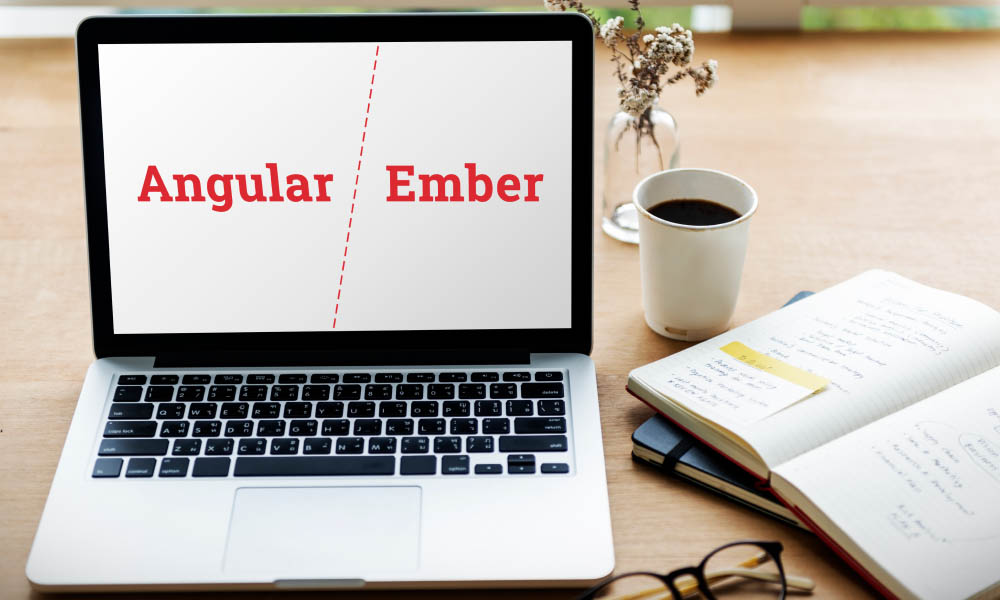
It is crucial to utilize front-end frameworks to make modern and interactive web apps. These frameworks make a standardized approach for crafting the front-end side, which enhances code consistency, efficiency, and maintainability.
The majority of frameworks make use of JavaScript as their source language. So in the matter of client-side development, JavaScript claims its monopoly since it’s the oldest technology existing for so long.
Talking about trending client-side frameworks, well, we can witness the two prevalent front-end frameworks competing – AngularJS vs EmberJS. But how can we determine the best pick out of these two?
For that, we have to look through the head-to-head comparison of Angular vs Ember to ascertain the best toolkit to work with. By understanding the comprehensive concept of these technologies, you can kick-start your next web project with ease; let’s have a look.
In Brief Review of AngularJS
AngularJS is a prevalent open-source JavaScript framework utilized for crafting dynamic apps for the web. It was designed by Google in 2009; however, the original author of Angular is Miško Hevery. It follows the Model-View-Controller (MVC) pattern.
With this framework, developers can compose reusable code, streamline the development procedure, and enhance the UI. AngularJS consists of several characteristics that count on the two-way data binding, directives, services, and dependency injection.
It likewise offers powerful testing attributes and a rich set of AngularJS development tools for crafting and debugging apps. In general, AngularJS is a versatile and high-powered JS framework that has gained widespread popularity among developers.
If we check the most used web frameworks statistics, we get to know that Angular is operated by 20.39% of developers at the global level, which is quite impressive.
In Brief Review of EmberJS
The original author of Ember is Yehuda Katz, but previously, it was reconsigned as the SproutCore 2.0 framework. Ember.js was launched in the year 2011, and at present, it has earned more than 20K stars on GitHub. This technology was invented to build dynamic and captivating user interfaces for any size of the project, no matter if it’s a small SPA solution or a large-scale enterprise project.
Ember.js makes use of HTML and CSS as its development model, which drove it easy for programmers to get a deep insight into the subject. This particular JavaScript framework follows a component-based approach and depends on the Handlebars templating engine.
One advantage of using Handlebars is that the templates will automatically adjust to any update in the data. Additionally, there are other useful features, such as Ember Inspector for debugging and a user-friendly API that comes with additional add-ons.
The usage reports of EmberJS suggest that it is utilized by less than 0.1 of websites globally. Now this signifies that the adoption of EmberJS is quite lower as compared to AngularJS.
Core Difference between AngularJS and EmberJS
| Basis | AngularJS | EmberJS |
|---|---|---|
| Original Author | Miško Hevery | Yehuda Katz |
| Initial Release | October 20, 2010 | December 8, 2011 |
| Routing | Requires Templates or Controller | More Robust Routing |
| Module | Angular supports a modular approach, where modules are employed to separate services, controllers, apps, etc. | Key segments within Ember.js are dedicated to routers, templates, models, and components. |
| License | MIT | MIT |
| Components | Its components can be reused. | Its components cannot be reused. |
| Debugging | Debugging the scope can be challenging for those who are new to this technology. | Debugging is quite easy compared to Angular because it utilizes the Ember inspector tool. |
| Data Binding | It follows Two-way Data binding. | It also follows Two-way Data binding. |
| Dependency | It does not count on any dependency. | It depends on Handlebars and jQuery. |
| GitHub Stars | 59.2K | 22.4K |
| Popular Webs Built With | YouTube, Upwork, Vevo, IBM, Weather, PayPal, Forbes | LinkedIn, Twitch, Netflix, Skylight, Zendesk, Square |
AngularJS vs EmberJS: Dissimilarities Need to Know About
Both these tech stacks share an equal vision to craft robust single-page applications. However, AngularJS can be used for web app development. On the contrary, Ember.js is even preferable for building robust desktop apps.
The Learning Curve
In Angular vs Ember, both technologies consist of tough education scenarios. For newbies, it can be challenging to grasp a deep understanding of Angular and Ember. However, Angular can be slightly easier to enroll in the first place as compared to the Ember framework.
The reason is that Angular provides more freedom to programmers in comparison with Ember since it allows dependability on further resources. On the opposite, Ember obeys a strict strategy for usage that can create a drawback for the fresher in the field to acquire the excellency of the framework.
Single Page Application
AngularJS is a better suitable option when you opt for building a high-performing single page application. It encloses no dependencies over jQuery or JavaScript, which makes it a more powerful framework than Ember to go for SPA projects.
No doubt Ember is as well popular, consequently, some well-known sites like LinkedIn, Twitch.tv, Live Nation, and more rely on Ember for its modern attributes. And usually, it’s great for SPA-like assignments too; regardless, it is much preferable to build desktop apps with Ember.
Testing
The testing support offered in Angular JS has been admirable ever since it came into existence. So Angular drove it painless for programmers to compose code and conduct testing with the easy usage of dependency injection. Angular has developed test runners like Protector to execute the end-to-end testing procedures.
During the original launch of Ember, it clearly failed to furnish an impressive testing strategy. However, by the time this issue got resolved, and now offers great testing support. Though testing results can not be considered preferable. So if we compare the testing manner in Angular vs Ember, then Angular is the clear winner.
Components
The component available in Angular is recognized as Directives, which are fairly powerful compared to Ember. With AngularJS, It is straightforward to compose reusable HTML syntax that assists in utilizing the semantics of codes in a formative way. Consequently, Angular has an ample approach for components in comparison with Ember.
Components are provided a widget-based method in Ember. So composing HTML tags has made it straightforward with the usage of Handlebars layout, which beings beneficial for creating app-specific HTML tags. Furthermore, It is likewise viable to break down HTML into tiny segments.
Modules
AngularJS supports and adheres to the Modular approach. Whereas these modules are utilized to separate services, controllers, etc. AngularJS offers two most favored modules, which are the Controller module and the Application module.
If we check on EmberJS, then it does not support the traditional modular approach. Rather than the core concepts in EmberJS are dedicated to Routers, Templates, Modules, and Components.
Data Binding
If we determine the data binding in AngularJS vs EmberJS, then we can understand that both these technologies take advantage of the two-way data binding procedure. But the thing is that AngularJS is an unopinionated framework and furnishes a piece of flexibility to launch your own client-side stack.
Moreover, Angular supports one-way data bindings as well, meaning that it holds great data binding ability compared to EmberJS. Hence with such a great capability of Angular, programmers can build cross-platform and feature-rich web applications.
Usage
As we have shown previously, AngularJS is mostly utilized for web app development. However, it is also a preferable choice to build powerful single-page applications.
On the other hand, Ember is widely used for multiple concepts of web design and development. Moreover, it’s also possible to build complex mobile apps with Ember.
Benefits and Drawbacks of Utilizing AngularJS
Plus Point;
- It is more straightforward to employ UI designs and alterations in Angular.
- Testing codes seems easier.
- Angular forms reusable components by utilizing directives while facilitating the extension of HTML syntax.
- It allows to build Document Object Model elements in a customized way.
- It includes some innovative concepts like two-way data binding that saves plenty of time in development.
- Some inbuilt components of Angular, such as DOM sanitization, make it the most secure front-end framework out there.
- Angular CLI is known as one of the best command-line tools existing in the JS ecosystem.
- Programmers can leverage the support from a giant community of Angular.
- The MVC architecture in Angular stands for the truly useful feature to simplify the development of the front-end side.
Negative Points;
- It’s become complex to integrate third-party objects into the framework.
- Scopes available in Angular are easy to use, but on the subject of debugging, it’s hard to get the job done.
- Angular is as well heavy in size; therefore, it doesn’t make an ideal choice to work with Angular for small-size projects.
- The original design of Angular is a bit slower.
- If pages contain various interactive elements, then it performs slower.
- The system’s performance is being negatively impacted by memory leakage, which can slow down the browser.
- It does not provide much flexibility.
- Dependency injection in Angular can be more time-consuming, and one has to stay focused while crafting component dependencies.
Benefits and Drawbacks of Utilizing EmberJS
Plus Point;
- EmberJS tend to perform heightened and supports JavaScript and Typescript.
- In Angular vs Ember, EmberJS consists of Full stack development alternatives.
- It is worth performing with Ember when you have large-scale project requirements.
- EmberJS makes use of COC ( Conversion over configuration ) that allows the designers to put efforts more on functionality rather than wasting time in decision-making.
- Coders can access a strong built-in router in EmberJS.
- This JavaScript framework is great for client-side rendering and can be utilized for scalable web app development outside of just the view layer.
- Additionally, the fully-fledged templating tool lowers the quantity of code demanded.
- Programmers can enjoy a seamless development experience since EmberJS proffers prompt rebuilds, auto-reload, and test runner functionalities that work together.
Negative Points;
- Just like Angular.js, Ember.js also consists of a lengthy education period.
- The major drawback of Ember is that it is too heavy in a manner of size.
- The components available in EmberJS cannot be reused.
- In the majority of small-scale projects, it’s not recommended not to perform with Ember.
- EmberJS has larger functions and class names, which result in a more extensive framework, and it can be challenging to manage.
- The framework lacks functionality at the Controller level, meaning it may demand further custom components for specific projects.
- Handlebars generate many “script” tags that lead to an increased DOM size and eventually impact the performance.
- It’s not that preferable to build non-traditional apps because of the inconvenient structure of Ember.js.
AngularJS vs EmberJS: Summary
In this article, we have looked through a comparison of two popular front-end frameworks – AngularJS vs EmberJS. Here one is a traditional framework toolkit, and the other one is a kindly fresh concept. No doubt both the concepts hold onto deep learning resources; however, AngularJS is way easier to get started, especially if you are not familiar with the JS field.
By going with AngularJS, there are very few chances of facing complexity. So it’s ideal to choose AngularJS over EmberJS to build web applications and SPA-like projects if you wish to save from complexity on the way of development.
Moreover, specifying the best alternative from these two frameworks majorly depends upon reckoning your application’s necessities. It is required to look thoroughly for the pros and cons of each framework along with how they perform to conduct specific tasks. Nevertheless, it’s truly a matter of subject to determine the best pick in Angular vs Ember.
Get an SPA project idea? Hire AngularJS developers from Elluminati to build robust and high-performing single-page applications for your business.









